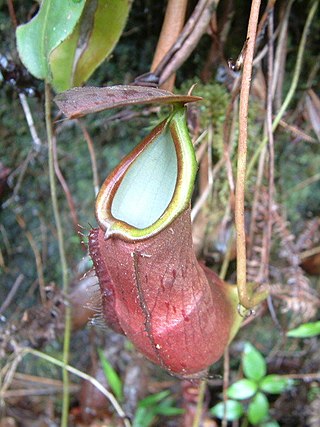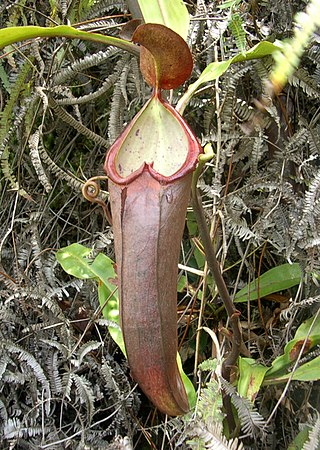
Colubridae is a family of snakes. With 249 genera, it is the largest snake family. The earliest species of the family date back to the Oligocene epoch. Colubrid snakes are found on every continent except Antarctica.

Salacca is a genus of about 20 species of palms native to Southeast Asia and the eastern Himalayas. They are dioecious and pollinated by Curculionidae beetles.

The Sumatran water shrew is a red-toothed shrew found only in the Padang highlands of western Sumatra, Indonesia. Its natural habitats are streams in montane forests. The species is only known from a holotype, which is damaged, and was previously listed as critically endangered by IUCN. It is believed to be severely threatened by habitat loss.

Nepenthes sumatrana is a tropical pitcher plant endemic to the Indonesian island of Sumatra, after which it is named.

Nepenthes longifolia is a tropical pitcher plant endemic to Sumatra, where it grows at elevations of between 300 and 1100 m above sea level. The specific epithet longifolia, formed from the Latin words longus (long) and folius (leaf), refers to the exceptionally large leaves of this species.

Nepenthes beccariana is a tropical pitcher plant. The species was described in 1908 by John Muirhead Macfarlane based on a specimen collected from the island of Nias, which lies off the western coast of Sumatra. It appears to be closely related to both N. longifolia and N. sumatrana, and the former is possibly a heterotypic synonym of this taxon.

The hairy-nosed otter is a semiaquatic mammal endemic to Southeast Asia and one of the rarest and least known otter species. It is threatened by loss of natural resources and poaching.

The great-billed heron is a wading bird of the heron family, resident from southeast Asia to Papua New Guinea and Australia.

Calamaria is a large genus of dwarf burrowing snakes of the family Colubridae. The genus contains 66 recognized species. The genus is endemic to Asia.
The Sumatran partridge, or Sumatran hill partridge, is a bird species in the family Phasianidae. It is found in highland forest in central Sumatra, Indonesia. It is sometimes treated as a subspecies of the grey-breasted partridge.

The barred eagle-owl, also called the Malay eagle-owl, is a species of eagle owl in the family Strigidae. It is a member of the large genus Ketupa which is distributed on most of the world's continents. This relatively little-known species is found from the southern Malay Peninsula down a string of several of the larger southeast Asian islands to as far as Borneo. It forms a superspecies with the physically similar but larger spot-bellied eagle-owl, although the two species appear to be allopatric in distribution.

The black-naped tern is an oceanic tern mostly found in tropical and subtropical areas of the Pacific and Indian Oceans. It is rarely found inland.

The Equatorial spitting cobra also called the black spitting cobra, Malayan spitting cobra, golden spitting cobra, Sumatran spitting cobra, or Palawan spitting cobra, is a species of spitting cobra found in Southeast Asia.
The Papuan black snake is a venomous snake of the family Elapidae native to New Guinea. Reaching around 2 m in length, it is a predominantly black snake coloured grey underneath.

Colubroidea is a superfamily of snakes in the clade Colubroides that includes Colubridae, with some studies splitting Colubridae into multiple families that make up Colubroidea. Historically, Colubroidea also included other caenophidian snakes such as cobras and vipers, as these snakes form a clade. However these groups are now divided into several distinct, but related, families. Zaher et al. (2009) proposed to redefine Colubroidea for colubrids and related families, while designating Colubroides as the group containing vipers and cobras as well as colubroids. The ReptileDatabase considers Colubroidea to be composed of Colubridae and the members of its sister group, Elapoidea, and does not recognize the division of Colubridae into multiple families.

The dark grey ground snake is a snake endemic to Indonesia and Malaysia.
Elapoidis is a genus of snakes endemic to Indonesia and Malaysia.
The black Sumatran langur is a species of monkey in the family Cercopithecidae. It was formerly considered a subspecies of the Sumatran surili, Presbytis melalophos but genetic analysis revealed that these are separate species. The black Sumatran langur is native to the island of Sumatra in Indonesia. It is listed as endangered by the IUCN due primarily to deforestation, and also due to animals taken for pets.

Calamaria sumatrana, the Sumatran reed snake or Sumatra dwarf snake, is a species of snake in the family, Colubridae. It is found in Indonesia.














